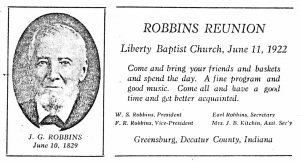The photo at the top of this website is a small portion of a much longer photograph of the 1922 Robbins Reunion in Decatur County, Indiana. One of the “stars” of this reunion was the oldest attendee, James Gilman Robbins. He was so prominent that his photo appeared on invitations to the event.

James Gilman Robbins was the third child of William and Eleanor (Anderson) Robbins. His siblings Sarilda (Robbins) Styers, John Everman Robbins, and Merritt Holman Robbins, were very successful and have interesting stories of their own, but this post focuses on James.
He lived his entire life in Decatur County, born there in 1829, and passing away near Horace in 1927. He was married to a woman with the indomitable name of Elmira Stout in 1853 and they had three children. Elmira’s father, the Rev. Joab Stout, was a Baptist minister at the Liberty Baptist Church, the later site of the 1922 reunion.
Besides the usual records that lay out his life’s timeline, a county history (A Genealogical and biographical record of Decatur County, Indiana, a compendium of national biography by Lewis Publishing Company) provide some additional details about his career, in the typical language of 1900 local histories:
“James G. Robbins was educated in the common schools and by hard work gained a practical knowledge of agriculture. He remained under the parental roof until he was twenty-five years old assisting in the farm operations of the homestead until he be came of age, when he and his brother Merritt (now dead) rented the place and managed it on their own account.”
“A few years later [after his marriage to Elmira] he went back to his father’s homestead, at his parents’ request, to afford them the care they required in their old age, and later inherited the place, which he subsequently gave to one of his own sons. He early gave intelligent attention to general farming and to the handling of stock, in which he was so successful that he gradually acquired a large amount of land. He has given to each of his children a good-sized farm and retains a fine home for himself.”

James G. Robbins was a large land owner in Decatur County, with his land laying southeast of Horace, in Sand Creek Township. He needed land for his next business venture.
“In 1876 he began breeding thoroughbred shorthorn cattle, purchasing stock in Kentucky for that purpose. He has made purchases since, always of first-class stock, and now owns the finest herd of cattle in eastern Indiana. He has made exhibits at various fairs and has always proven a formidable competitor, He has sold calves in about every state and territory in the United States and is known throughout the entire country as one of America’s leading stockmen. He is an honorable, enterprising, successful and public-spirited man, independent in his views, and influential as an earnest Republican who has never sought and would not accept any public office.”
Shorthorn cattle were developed in Britain in the 18th century and had become a popular breed, with both a dairy and a beef variety, with the American Shorthorn Association established in 1874. James’s interest in cattle was passed down through his family. In fact, his grandson-in-law Arthur C. Stewart, with his sons Gilman and John, established Stewart Select Angus in Greensburg in 1954, with descendants of James Gilman Robbins carrying on the business and the tradition to the current day. You can read about their history at the Stewart Select Angus website.
James outlived his wife, his siblings and all his in-laws. He was, without a doubt, the “grand old man” of the Robbins Reunion in 1922.
[Jacob Robbins-William Robbins-William Robbins Jr.-James Gilman Robbins]







